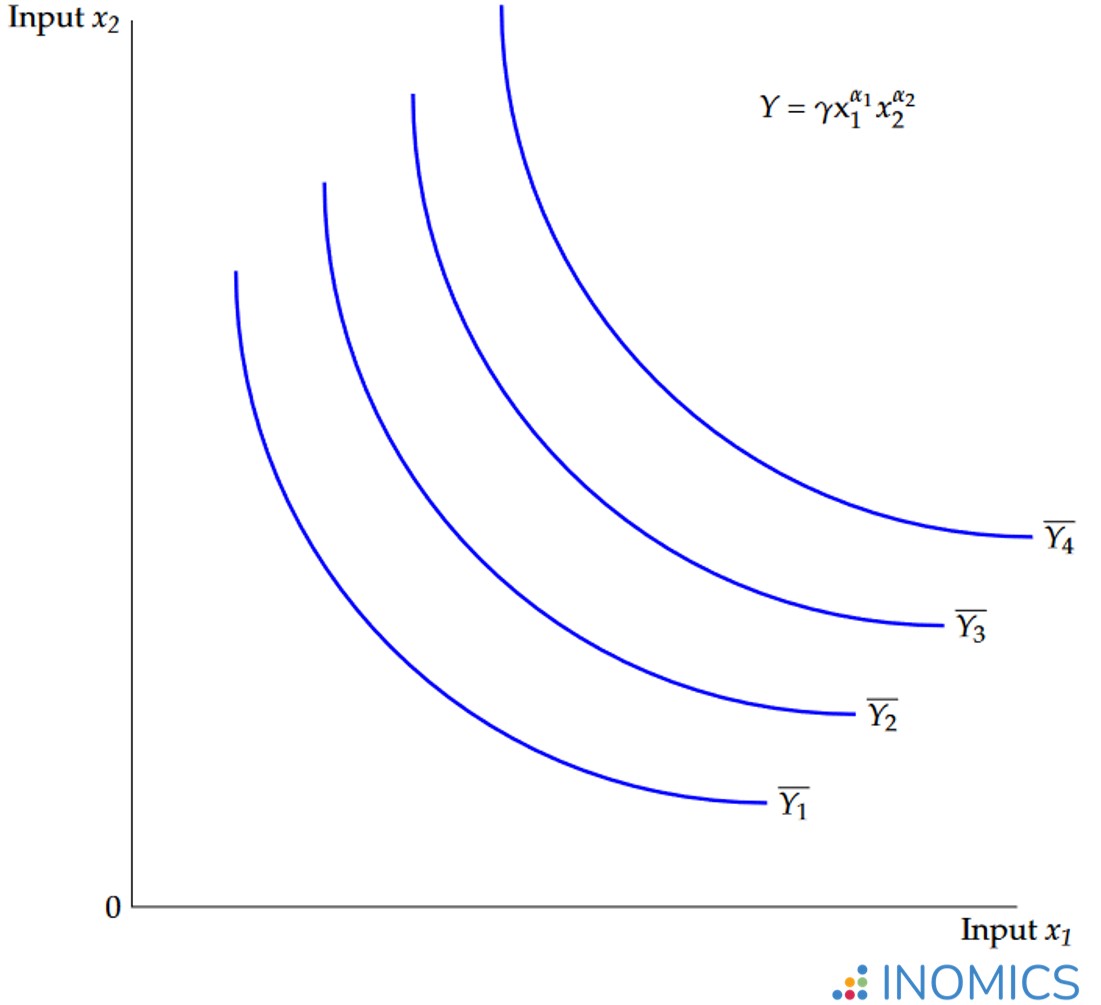Economics Terms A-Z
Cobb-Douglas Production Function
Read a summary or generate practice questions using the INOMICS AI tool
A Cobb-Douglas production function models the relationship between output and production inputs (also known as factor inputs). It is used to calculate ratios of inputs to one another for efficient production, and to estimate technological change in production methods. It’s a commonly used economic model that is very flexible, and as such is often one of the first models students of macroeconomics will learn (though it’s also used in microeconomics, too).
The application of this functional form in measuring production is owed to the mathematician Charles Cobb and the economist Paul Douglas, after whom it is named. They originally used it to consider the relative importance of the two main input factors, labor and capital, in manufacturing output in the USA from 1899 to 1922.
The general form of a Cobb-Douglas production function for a set of \(n\) inputs is
\[Y=f\left(x_{1},x_{2},...,x_{n}\right)=\gamma\prod^{n}_{i=1}x^{\alpha_{i}}_{i}\]
In this formula \(Y\) stands for output (as measured by, for example, GDP), and \(x_{i}\) for input \(i\). Meanwhile \(\gamma\) and \(\alpha_{i}\) are parameters determining the overall efficiency of production and how output responds to changes in the input quantities.
In their original model, Cobb and Douglas restrict the output-elasticity parameters \(\alpha_{1}\) and \(\alpha_{2}\) to the range \(\alpha_{i}\in\left(0,1\right)\) and to sum to one, which implies constant returns to scale.
Reading the above equation might be challenging for new students of economics. For help interpreting economic formulae, see the linked article “A quick guide to math symbols in economics”. Reading this equation is straightforward once the symbols are all identified; the Cobb-Douglas function is the product of multiple xi (specifically n of these xi), each raised to the αi power, and the resulting product is multiplied by the parameter 𝛾.
Applying Cobb and Douglas’s model to the production of a two-factor economy (using inputs x1 and x2) simplifies the above expression. The resulting function becomes
\[Y=\gamma x^{\alpha_{1}}_{1}x^{1-\alpha_{1}}_{2}\]
where \(x_{1}\) and \(x_{2}\) stand for labor and capital, respectively. Note that the two exponents simplify to α1 and (1 - α1) because Cobb and Douglas assumed they must add to one (again, showing constant returns to scale). Another common representation of this formula that macroeconomics students may see is:
\begin{equation*}\mathit{Y} = \mathit{A}\mathit{L}^{\alpha}\mathit{K}^{\beta}\end{equation*}
where L represents labor, K represents capital, 𝛼 and 𝛽 are efficiency parameters as above, and A represents productivity-enhancing technological progress (just as 𝛾 above). Taking the natural logarithm of both sides of the first equation yields
\[\ln{Y}=\ln{\gamma}+\alpha_{1}\ln{x_{1}}+\left(1-\alpha_{1}\right)\ln{x_{2}}\]
such that for data on output, labor and capital, the parameters \(\gamma\) and \(\alpha_{1}\) can be estimated using Ordinary Least Squares, a common method used in regression analysis.
Based on their data, Cobb and Douglas found a value of 0.75 for \(\alpha_{1}\) in the US. This implies that labor accounted for three quarters of the value of US manufacturing output (capital accounting for the remaining quarter) from 1899 to 1922.
Their estimate for the efficiency parameter \(\gamma\) is 1.01. Since it is greater than 1, this reflects the positive effects of "unobservable" forces (like technology growth) on production through the combination of labor and capital.
The multiplicative nature of a Cobb-Douglas production function, assuming positive values for \(\alpha_{i}\), means that the inputs are complements in production. In the standard model of labor and capital, increasing the amount of capital increases production both directly and indirectly through its impact on the productivity of labor.
Or, stated mathematically, the cross-partial derivative of production output \(Y\) with respect to labor \(x_{1}\) and capital \(x_{2}\) is positive.
Furthermore, due to the assumption that \(\alpha_{i}\in\left(0,1\right)\), the second-order partial derivatives of production output with respect to labor and with respect to capital are both negative. This suggests diminishing marginal returns for each input. This means that simply adding either more labor or more capital (but not both) to the production process increases output, but at a diminishing rate.
Additionally, the elasticity of substitution between the inputs is constant and equal to one due to the functional form. A two-input Cobb-Douglas production function can be represented graphically in the form of isoquants: combinations of both inputs for which the output is constant.
There are four such isoquants in Figure 1 for the (constant) output levels \(\overline{Y_{1}}\), \(\overline{Y_{2}}\), \(\overline{Y_{3}}\) and \(\overline{Y_{4}}\). The further the isoquant from the origin, the greater the level of output \(\overline{Y_{4}}>\overline{Y_{3}}>\overline{Y_{2}}>\overline{Y_{1}}\).
Which precise combination of the inputs \(x_{1}\) and \(x_{2}\) is optimal for production is determined by the budget available to the producer as well as the cost ratio of input \(x_{2}\) to input \(x_{1}\). These factors can be included in the graph in the form of an isocost line (see the article on elasticity of substitution).

Figure 1: Cobb-Douglas production function isoquants
Cobb and Douglas themselves acknowledged that their production function does not rest on solid theoretical foundations, nor should it be understood as a law of production. It merely represents a statistical approximation of the observed relationships between production inputs and output. Nevertheless, its simple mathematical properties are attractive to economists and have led to it becoming a standard model used in economic theory over the past century.
Further reading
For the background and an overview of the main properties of Cobb-Douglas production functions, see in particular sections 6, 7 and 8 of Cobb and Douglas’ original article, “A Theory of Production” (The American Economic Review, 1928).
Good to know
The Cobb-Douglas functional form is not only used in the theory of production but it has also become standard in microeconomic consumer theory. There it is applied as a utility function, where \(Y\) becomes \(U\) for utility. The \(x_{i}\) then represent items of consumption. When the utility function is maximized, subject to a budget constraint, the values for \(\alpha_{i}\) indicate how the individual will optimally distribute their budget among items.
-
- Master's Program
- Posted 2 weeks ago
MSc/PhD in Economics (IDEA) - Barcelona
Starts 1 Sep at Universitat Autònoma de Barcelona in Barcelona, Spain
-
- Assistant Professor / Lecturer Job, Professor Job
- Posted 1 week ago
Lecturer / Senior Lecturer in Economics
At University of Canterbury in Christchurch, New Zealand
-
- Summer School
- Posted 1 week ago
BSE Summer School 2026: Economics, Finance, Data Science, and related fields
Starts 22 Jun at Barcelona School of Economics in Barcelona, Spain

















